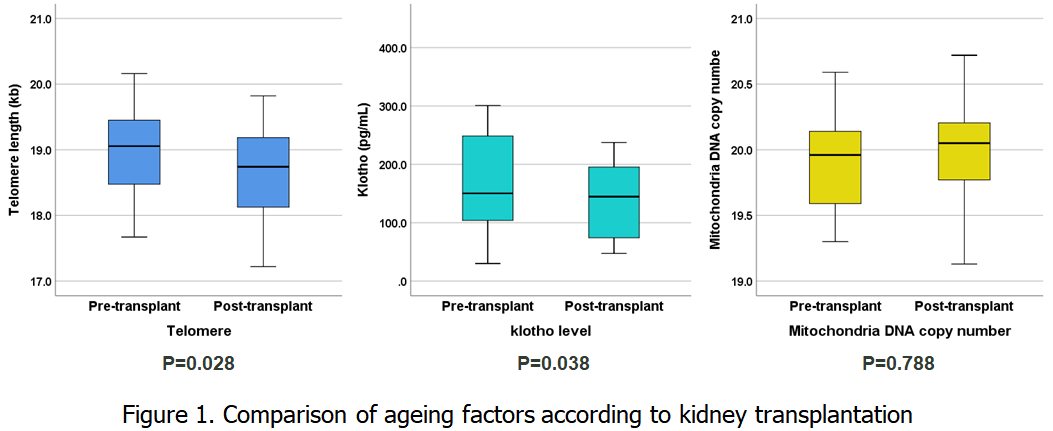
Association of aging-related markers in kidney transplant recipients
Woo Yeong Park1, Jaeseok Yang1, Jin Kyung Kwon1, Yaerim Kim1, Jin Hyuk Paek1, Kyubok Jin1, Dae-Kwang Kim2, Seungyeup Han1.
1Division of Nephrology, Department of Internal Medicine, Keimyung University School of Medicine, Keimyung University Dongsan Hospital, Daegu, Korea; 2Department of Medical Genetics, School of Medicine, Keimyung University, Daegu, Korea
Introduction: Shortening of telomere length and mitochondrial dysfunction are known as major factors in the aging process in the general population, and it is also predicted to be related to the anti-aging gene, klotho gene, but there are few studies on this in kidney transplant recipients (KTRs).
Method: Among 490 KTRs, 24 KTRs with blood samples stored in the Human Resources Bank were enrolled. We measured the telomere length, mitochondrial DNA copy number and serum klotho levels before and after KT, and analyzed the association between the laboratory results and the medical status in KTRs.
Results: Mean age of KTRs was 46.9 ± 12.7 years, body mass index, 23.0 ± 3.1 kg/m2, and there were 13 living and 11 deceased donor KT. Mean age of donor was 50.6 ± 11.6 years. Telomere length was significantly decreased (P=0.028), and the klotho level was also significantly decreased (P=0.038) before and after KT. There was no significant decrease in mitochondrial DNA copy number (P=0.788). Changes in telomere length and klotho levels were lower in KTRs over 60 years of age. KTRs with acute rejection within 1 year after KT tended to have lower telomere length and klotho levels than those without acute rejection. Comparing KTRs with the lengthened and shortened telomeres before and after KT, there was no difference in initial allograft function, but the shortened group tended to decrease in long-term allograft function. KTRs with decreased klotho levels before and after KT tended to have poorer initial allograft function. KTRs with shortened telomeres showed a lower allograft survival rate than those with lengthened telomeres. There was no significant association between changes in telomere length and those in klotho levels.
Conclusions: We did not find a significant association between telomere length and klotho levels in KTRs. However, changes in telomere length and klotho levels were associated with allograft function, respectively. Therefore, it might be used as a biomarker that indicates the prognosis of allograft function through changes in telomere length and klotho levels.

[1] Kidney transplantation
[2] Klotho
[3] Telomere
[4] DNA copy number
